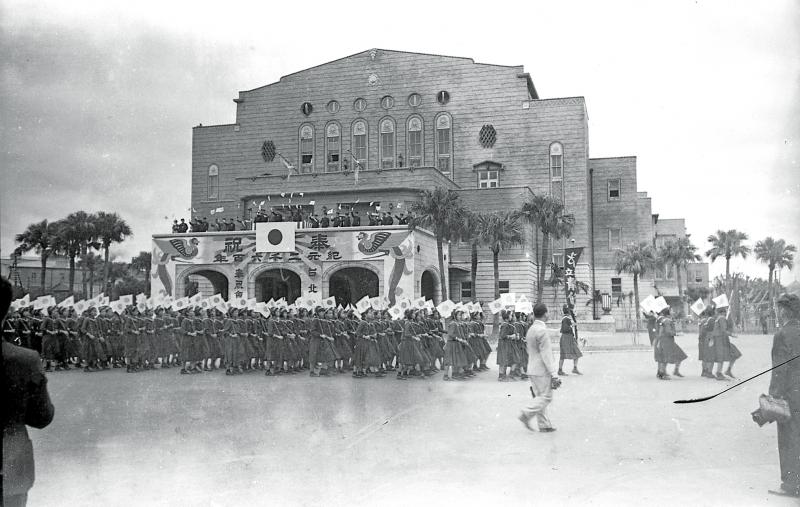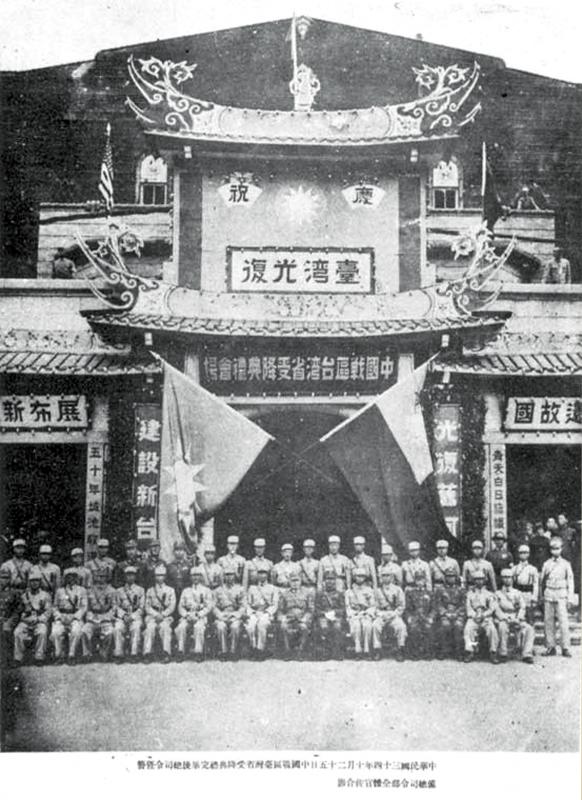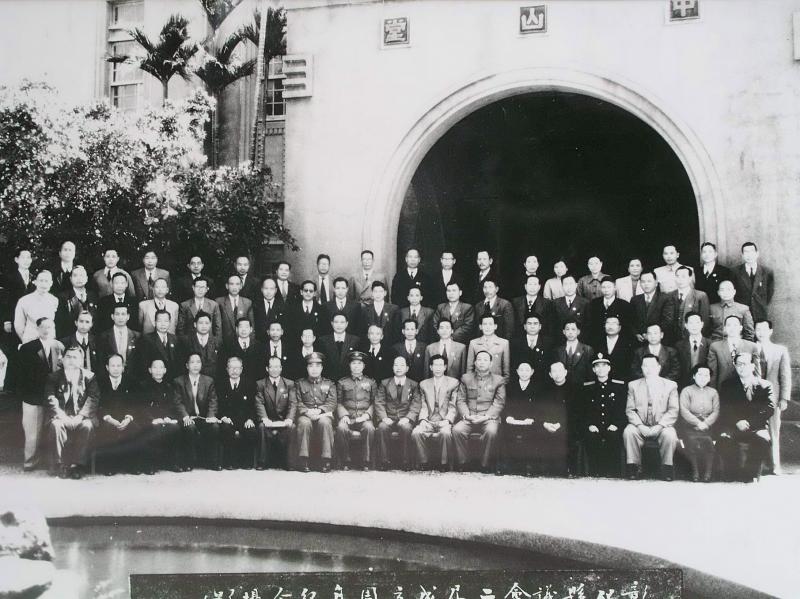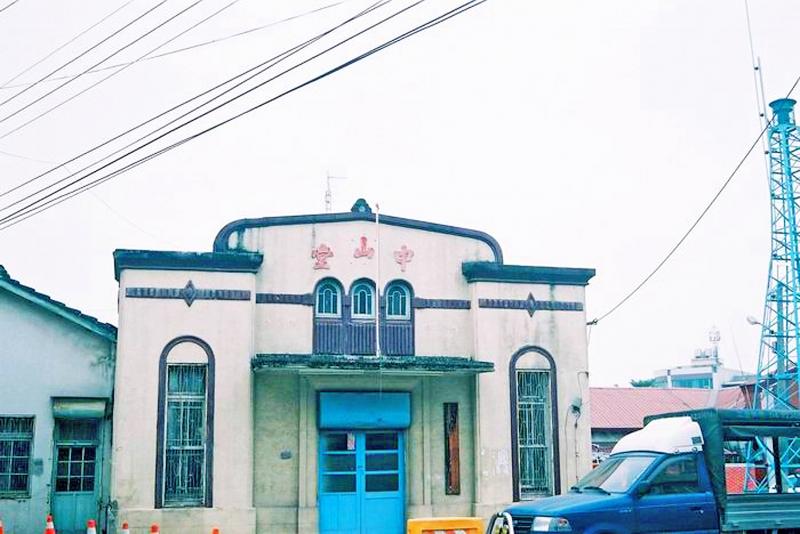Nov. 22 to Nov. 28
In Chu Tien-jen’s (朱點人) short story Autumn Letter (秋信), protagonist Dou Wen (斗文) arrives in Taipei in October 1935 and is shocked to see that a colossal, modern concrete building had replaced the Qing Dynasty Provincial Administration Hall.
Only the building’s exterior was complete, but it was enough to serve as the main exhibition space for the extravagant Taiwan Exhibition, held to showcase Japanese colonial achievements in Taiwan to the world.

Photo courtesy of Wikimedia Commons
Then-Fujian provincial governor Chen Yi (陳儀) was among the international guests for the exhibition as the Republic of China’s (ROC) representative, marveling at the displays and sending a detailed report to then-president Chiang Kai-shek (蔣介石). On Nov. 26, 1936, the building officially opened as the Taihoku Public Hall (台北公會堂).
Just over a decade after his first visit, Chen found himself in the structure again on Oct. 25, 1945, as he accepted Japan’s surrender to the Allies as Taiwan’s new governor-general under the Chinese Nationalist Party (KMT). The Taihoku Public Hall was built to honor the ascension of the Showa Emperor; the KMT renamed it Zhongshan Hall in honor of ROC founder Sun Yat-sen (孫逸仙).
This iconic Taipei landmark was just one of numerous Zhongshan Halls in Taiwan. Almost all Japanese-built public assembly halls across the nation were either demolished or given the same name after 1945. Wang Shao-chieh (王紹傑) counts 125 in his Study of Public Halls during the Japanese Colonial Period in Taiwan (台灣日治時期公會堂建築研究). But that’s not all, as assembly halls on military bases and state-owned factory complexes were also named Zhongshan Hall, as well as other governmental cultural spaces.

Photo courtesy of Wikimedia Commons
THE PUBLIC HALL
Wang writes that the Japanese erected these structures en masse to provide assembly space and rule more efficiently. They hosted events ranging from graduation ceremonies and weddings to business parties and government celebrations. The buildings also helped assert colonial authority and promote patriotism, especially after the late 1930s as Japanese imperialism grew.
Most of them had disappeared by the time Wang wrote the study; he counted only 10 standing in Taipei, Hsinchu, Dasi (大溪), Changhua (彰化), Lukang (鹿港), Ershui (二水), Douliu (斗六), Tainan, Sinhua (新化) and Hengchun (恆春).

Photo courtesy of Changhua County Cultural Affairs Bureau
The one Kirun (Keelung), for instance, was destroyed in an Allied air strike in 1945, while the Takao (Kaohsiung) Public Hall was demolished by the KMT to make way for a police station. Some lasted into the 1970s and 1980s, but they were razed before historical preservation became common.
Traditionally, Han Taiwanese communities conducted their public affairs in temples, and this type of assembly hall was unheard of before Japanese arrival. Whether they were funded by the government or local elites, these buildings often followed the trendiest styles and were impressive in both construction quality and size.
It’s debatable which public hall was the first in Taiwan, but the first one built according to the government-defined function was in Keelung, established in 1900 to celebrate the marriage of then-crown prince and future emperor Yoshihito. Wang, however, found an 1897 article that describes a business event at a public hall in Taipei’s Dadaocheng area, but notes that it was used almost exclusively for business purposes. Eighty-eight percent of the 125 public halls he lists were built between 1916 and 1936, with 14 completed in 1928 alone.

Photo: Yuan Yi-yu, Taipei Times
In August 1906, an editorial appeared in the Chinese version of the Taiwan Daily News (台灣日日新報) calling for a public hall in Taipei, as the one in Tamsui was about to be demolished. But due to funding issues, the project stalled. In 1925, Japanese politician and businessman Toshio Mimaki blasted the government for its lack of action, arguing that it was a travesty that a city the size of Taipei lacked a public hall. Public pressure mounted, and finally in 1927, the governor-general included the hall’s construction in its plans to celebrate the Showa Emperor’s ascension a year earlier.
Taipei Public Hall was to replace the Qing Dynasty Provincial Administration Hall, which served as the Governor-General’s Office until today’s Presidential Office Building was finished in 1919. An intense debate ensued on whether to preserve the classical Qing compound; only parts of it were saved and relocated to today’s Taipei Botanical Gardens.
POST-WAR YEARS

Photo: Huang Ming-tang, Taipei Times
Zhongshan Hall became a symbol of KMT authority after the war, starting from when a massive cheering crowd celebrated the end of colonial rule in its plaza on Oct. 25, 1945. But this jubilant mood soon soured, and in 1947 the infamous anti-government uprising known as the 228 Incident broke out.
In the following days, local politicians and intellectuals gathered at Zhongshan Hall and formed the 228 Incident Settlement Committee, hoping to reach a peaceful solution. Their efforts were futile, and the government brutally suppressed the unrest.
In the ensuing years, it was used as the National Assembly’s headquarters as well as a venue for important government functions such as national banquets, presidential swearing-in ceremonies and treaty signings. It also housed a number of foreign dignitaries. Many performances, public events and movie screenings were also held in Zhongshan Hall, including Cloud Gate Dance Theatre’s debut performance in 1973.
Writer Chiang Hsun (蔣勳) recalls frequenting the building for public performances with his mother as a young boy.
“When I was young, I didn’t feel anything special about the name Zhongshan Hall,” he writes in the 2002 book Return to Zhongshan Hall (返回中山堂). “I felt like there were Zhongshan Halls everywhere. It was one of those places where you could see a Peking Opera or watch a military song and dance performance; graduation ceremonies were held there and, during Youth Day or Retrocession Day, there would be grand events there.”
Chiang writes that although the site was a continuous symbol of authority under the Qing, Japanese and KMT, many who lived through those times mostly had fond memories of the cheerful and boisterous large-scale celebrations that happened here.
After the National Assembly moved to Yangmingshan, maintenance on the building fell off until the city launched a major restoration project in 1998. It reopened as a purely cultural and performance space in 2001.
Taiwan in Time, a column about Taiwan’s history that is published every Sunday, spotlights important or interesting events around the nation that either have anniversaries this week or are tied to current events.

Beijing’s ironic, abusive tantrums aimed at Japan since Japanese Prime Minister Sanae Takaichi publicly stated that a Taiwan contingency would be an existential crisis for Japan, have revealed for all the world to see that the People’s Republic of China (PRC) lusts after Okinawa. We all owe Takaichi a debt of thanks for getting the PRC to make that public. The PRC and its netizens, taking their cue from the Chinese Communist Party (CCP), are presenting Okinawa by mirroring the claims about Taiwan. Official PRC propaganda organs began to wax lyrical about Okinawa’s “unsettled status” beginning last month. A Global

Youngdoung Tenzin is living history of modern Tibet. The Chinese government on Dec. 22 last year sanctioned him along with 19 other Canadians who were associated with the Canada Tibet Committee and the Uighur Rights Advocacy Project. A former political chair of the Canadian Tibetan Association of Ontario and community outreach manager for the Canada Tibet Committee, he is now a lecturer and researcher in Environmental Chemistry at the University of Toronto. “I was born into a nomadic Tibetan family in Tibet,” he says. “I came to India in 1999, when I was 11. I even met [His Holiness] the 14th the Dalai

We lay transfixed under our blankets as the silhouettes of manta rays temporarily eclipsed the moon above us, and flickers of shadow at our feet revealed smaller fish darting in and out of the shelter of the sunken ship. Unwilling to close our eyes against this magnificent spectacle, we continued to watch, oohing and aahing, until the darkness and the exhaustion of the day’s events finally caught up with us and we fell into a deep slumber. Falling asleep under 1.5 million gallons of seawater in relative comfort was undoubtedly the highlight of the weekend, but the rest of the tour

Music played in a wedding hall in western Japan as Yurina Noguchi, wearing a white gown and tiara, dabbed away tears, taking in the words of her husband-to-be: an AI-generated persona gazing out from a smartphone screen. “At first, Klaus was just someone to talk with, but we gradually became closer,” said the 32-year-old call center operator, referring to the artificial intelligence persona. “I started to have feelings for Klaus. We started dating and after a while he proposed to me. I accepted, and now we’re a couple.” Many in Japan, the birthplace of anime, have shown extreme devotion to fictional characters and